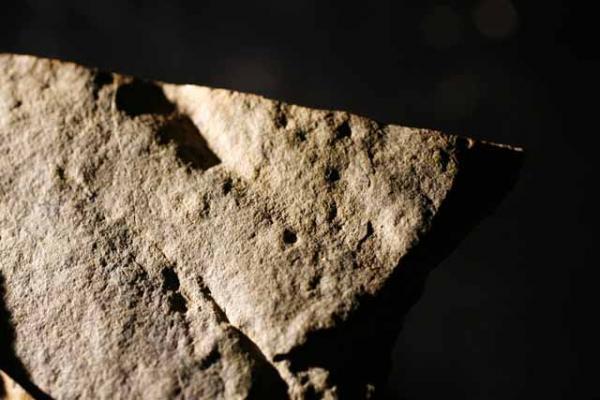The earliest footprint of animals
The fossil record of an aquatic animal shows that animals are walking at least 30 million years earlier than expected. The trace was found - two parallel lines of small dots about 2 millimeters in diameter - dating back 570 million years to the Ediacaran period.
Ediacaran era is just before the Cambrian period, the period when most of the main squatters began to evolve.
Scientists once thought it was simple bacteria or multicellular animals that existed before the Cambrian period, but that thought was changing, explained Loren Babcock, professor of earth science at Ohio State University.
He said: 'We are always looking at the ability of more complex animals in the Ediacaran era - soft lakes, arthropods, and flukes - but the evidence found is still not completely convincing . If you look for evidence like ours on moving animals, the aforementioned ability is very well grounded. '
Soo-Yeun Ahn, a doctoral student at Ohio State University, presented the findings at the American Geological Society's Houston conference. Co-authors include Margaret Rees of Nevada University, Las Vegas, and J. Stewart Hollingsworth of the Cambrian Research Institute.
Babcok is studying rocks in the mountains near Goldfield, Nevada with Hollingsworth in 2000 while hugging the traces.
'This is really a random discovery. We had a rising layer of soil that seemed to be between the Cambrian and Cambrian money boundaries, so we stopped to look. We sat down and started to flip the stones up. In just about an hour I found that trace '.

Traces of one of the earliest animals, a multi-legged creature that walks on the seabed of an ancient sea that once covered Nevada.This animal leaves two parallel trace lines including small and round dots in the mud that later become rocks.(Photo: Kevin Fitzsimons, Ohio State State University).
The creature only steps lightly on the sea sediment, because its feet only leave a very shallow impression on the position that used to be the seabed. However, when Babcok flipped the stone containing that important trace, the sun at a low angle made the dots on the island appear very clearly.He said the trace was of an arthropod, like a centipede, or a leg-moving worm.
He could not be sure about the length of the creature, or the number of its legs. But from the trace, he guessed that the body of the creature was centimeters wide with many slender legs.
In 2002, other researchers reported a similar fossil track from Canada dating to the middle of the Cambrian period, about 520 million years ago . Another trace is found in southern China dating back 540 million years ago .
For the 570 million years ago, this new fossil not only provided the earliest known footprints in the world, but also showed that complex animals appeared on the earth before the Cambrian.
Not many large fossils existed since that period because the body of the mollusks is often not preserved for long.
Babcock is an expert in 'special conservation' - special chemical, physical and biological conditions that allow molluscs to fossilize. Knowing how to search for geological records, he discovered many strange fossils, from echinoderms in Nevada to sulfur-eating bacteria in Antarctica.
The shallow sea covering eastern Nevada 570 million years ago is an appropriate location for unusual conservation processes. Sediment surface may be associated with microbial mats - a layer that attaches between bacteria and sediment. Traces of the creature can easily be saved when it steps on the sediment.
Babcok said he was not 100% sure that the challenge was caused by a centipede-like arthropod or a leg-like worm. A fossil of the animal itself can bring a clearer concept. He will continue to search in Nevada, but that is not the only potential location. Similar fossils can be found in the White Sea region of Russia, Southern Australia, Newfoundland or Namibia, where fossils of Ediacaran's autism have been discovered.
Babcok said about the discovery: 'I think there will be a lot of doubts. However I think it will create a certain level of interest. Some people will probably look more closely at the stones they find. Sometimes it's just a matter of thinking differently about the same specimen. '
- Discover the earliest ancestors of humankind
- Fossil animal world's smallest footprint
- Discover the oldest fossil animal footprint ever
- Typical footprints of animals in the world
- Recreate the 3-dimensional structure of the oldest animals on earth
- The bright yellow footprint floated in the sky
- The nation welcomes the earliest and latest year 2017 in the world
- The mysterious footprint of the Snowman in Nepal
- Spot the first star of the universe
- Find the fossil of 4-legged animals at the earliest
- Discover the world's largest dinosaur footprint in Australia
- Strange 'footprint' in the deep sea
 Discovered an ancient centipede fossil 99 million years old
Discovered an ancient centipede fossil 99 million years old Discovered bat-like dinosaurs in China
Discovered bat-like dinosaurs in China Discovered a 200-year-old bronze cannon of the coast
Discovered a 200-year-old bronze cannon of the coast Discover 305 million-year-old spider fossils
Discover 305 million-year-old spider fossils